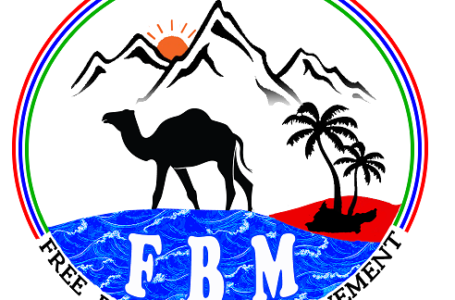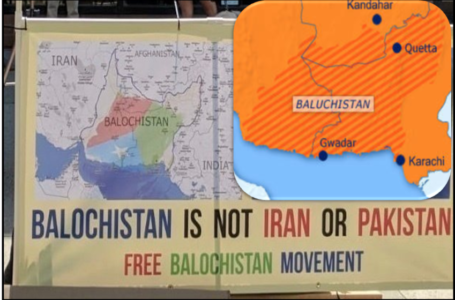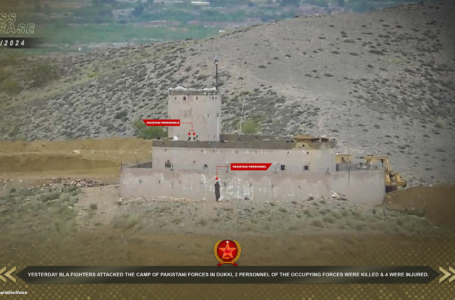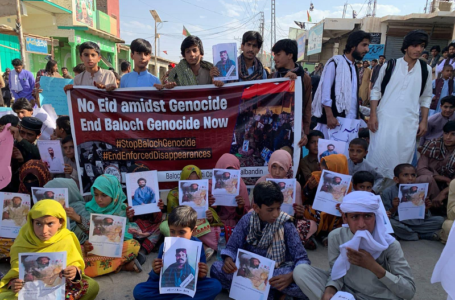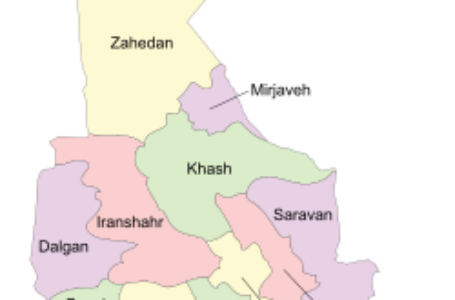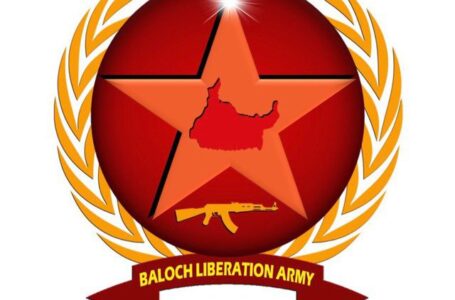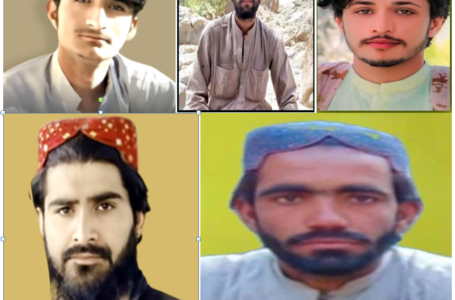Balochistan: Two Personnel of Pakistani Forces Killed in Dukki Attack
Balochistan Occupation Day – 27 March 1948

One policy that all empires employ to prolong their colonial rules is the policy of ‘divide and rule.’ British Imperial rulers applied this policy most effectively in India. British colonial conquest of India has been far-reaching. It has also spread outside Indian borders. British invaded Balochistan in 1839 to shield India from outsiders. After the occupation of Balochistan, British divided Balochistan into three parts to weaken Baloch struggle for independence.
One can seek the root of Islamo-fascism in Pakistan in British imperial policy of ‘divide and rule’ in India. Most of Indian Muslim converted to Islam after the Turkish Ghaznavids invasion of India from mid-thirteenth century onwards. The ancestors of Genghis Khan adopted Islam as their religion after their invasion of Iran and central Asia. Shah Tughlaq (1351-85) declared: “I encourage my infidel subjects to embrace the religion of the prophet, and I proclaimed that everyone who repeated the creed and became a Muslim should be exempt from jizya [Tax]” (Quoted in A. Dasgupta, 1993, A History of Indian Economic Thought p. 45).
Muslim card became one of the most destructive instruments of the British policy of divide and rule in India. Progressive secular Indians set up the Indian National Congress on 28 December 1885. In opposition to Indian Congress, a group of Indian Muslims headed by Sayyid Ahmad Khan with the active support of British officials founded the All-India Muhammadan Educational Conference in 1886. G.J. Elliot-Murray-Kynynumound (1845-1914), the 4th Earl of Minto, the Viceroy of India (1905-10) approved the Indian Muslim landlords and nobilities’ request for special representation for Muslim in provincial legislative councils in 1906. Its scheme segregated the Muslims from the rest of Indian population and established separate electorates for Muslims with additional seats in relation to their population. Lord Minto’s wife noted the significance of this policy in her diary as an act that prevented “sixty-two million people [Indian Muslims] from joining the ranks of the seditious opposition.”
It was in the December of the same year (1906) that the same group with much of the Indian colonizers’ financial and political supports set up the first Muslim political party in the name of the Muslim League. The first article of Muslim League leaves no doubt about the chief objective of the party. It says the principal aim of the party is “to promote among Mussalmans [Muslims] of India, feelings of loyalty to the British government.”
Among British colonial rulers, as it is common among all colonial rulers, their rule in India was perceived to be forever. The events of the Second World War profoundly shook this groundless delusion. The events of the war endorsed the Muslim League to become the co-partner of their colonizers. The British colonial rulers needed their die-hard servants in India more than any other time. V. A. John Hope, 2nd Marquess of Linlithgow (1887–1952), Viceroy of India (1936 – 43), approached the leader of Muslim League, Muhammad Ali Jinnah in 1939 to sabotage the Indian Congress demand for independence. By mid-1940 Indian British accepted the inevitability of Indian independence.
British used Islam as a blunt instrument to subdue Indian democratic struggle for independence. They knew that Indian independence meant the end of their Empire. British feared that they would not only lose India but all their political and military influence in the region. So they dictated and executed the partition plan on religious lines. Field Marshal Archibald Percival Wavell (1883–1950) was a key monitor of the design. He served as commander-in-chief (1941–43) in India and from 1943 to 1947 he was the British viceroy in India. He provided all the supports needed to the Muslim League and boosted Jinnah’s ranking in Indian politics. He concentrated his military forces around the northwest of India by 1944.
Winston Churchill (1874–1965) was the British prime minister then (1940–45). He was the head of the Empire and a typical political and moral representative of the British Empire. He viewed colonialism as a British natural right. Churchill in addressing the Peel Commission in 1937 said that “I do not admit for instance, that a great wrong has been done to the Red Indians of America or the black people of Australia. I do not admit that a wrong has been done to these people by the fact that a stronger race, a higher-grade race, a more worldly wise race to put it that way, has come in and taken their place.” To Churchill, the colonized nations were unfit to rule themselves. He described M. K. Gandhi (1869–1948) the leader of the Indian independence movement as “a seditious Middle Temple lawyer of the type well-known in the East, now posing as a fakir, striding half-naked up the steps of the Viceregal palace to parley on equal terms with the representative of the King-Emperor” (The Times 24 February 1931).
As a faithful guardian of British Empire, for Churchill an independent India was inconceivable. Wavell asserts that by March 1945, he yielded to the new reality and changed his position about Indian Independence. According to Wavell, he opted for “partition of India into Pakistan, Hindustan and Princestan.” In July of the same year (1945) Churchill lost the general election to Clement Attlee (1883–1967). In the August 1945, Wavell visited London to discuss the situation with the new prime minister. He also met Churchill. Wavell recalls that while leaving the meeting Churchill saying “keep a bit of India.” After these meetings, all British effort was channelled to the dismemberment of the Indian. Field Marshal Bernard Law Montgomery (1887–1976), the military chief staff, wanted to secure a military base in the region. He argued that Pakistan can be used as a base for “airfields and ports in northwest India.”
It was at this time that the term “Pakistan” became handy to the British establishment. The term was coined by Chaudhry Rahmat Ali, a fundamentalist Indian Muslim in 1933. The term is a xenophobic term, which means ‘the land of the clean people.’ It intended to divide Indian people into clean and unclean people; designating Indian Muslims as clean and Indian Hindus as unclean. When the time of partition came, the areas of partition were two Indian provinces, the provinces of Punjab and Bengal. It was decided west Punjab would form West Pakistan and the East Bengal East Pakistan. The members of legislative assemblies of Punjab and Bengal were given the task to decide the lines of partition on basis of simple majority. The Boundary Commissions comprised of Punjab, the Indian side, and the Pakistani side. Justice Mehr Chand Mahajan and Teja Singh represented the Punjabi Indian side and the Pakistani side (western Punjab) were represented by Din Mohamed and Muhammad Munir. From Bengal, Indian sides were Justice C.C. Biswas and B.K. Mukherji, for eastern Pakistan side were Abu Saleh Mohamed Akram and S.A. Rahman. Cyril Radcliffe (1899-1977) led both commissions. Two sides did not agree on the partition lines so Radcliff drew the lines and divided India in few minutes! This is how Pakistan was created. In the first year of the partition of India, it is estimated that about 10 to 12 million people were displaced and about 1.5 million civilians were massacred (Partition-August 1947, GlobalSecurity.org).
The Baloch struggle for independence from Britain continued until Baloch regained their independence on 11 August 1947. However, the Baloch freedom lasts only for few months. The newly created state of Pakistan invaded Balochistan on 27 March 1948. From the very day that Punjabi army of Pakistan has invaded and annexed Balochistan, Baloch has persistently continued their struggle to reclaim their freedom. Ever since the Punjabi rulers of Pakistan have carried out five major military operations in Balochistan. One of these major military operations was during 1973-77. In the course of this period, the Baloch Sarmachars (freedom fighters) managed to liberate Balochistan from Pakistan for a short period. About 90,000 Punjabi Islamic mercenaries were dispatched to Balochistan where they were confronted with 60,000 Baloch partisans. It is estimated that the Pakistani army has killed about 15,000 to 25,000 Baloch people during this time.
The latest Pakistani military operation in Balochistan began in 2002. Since then the Pakistani security forces have killed many thousands of Baloch people. Tens of thousands of Baloch political and human rights activists have been abducted and disappeared. Three mass graves were discovered so far in Tootak, Khuzdar on 17 January 2014, which contained the decomposed bodies of many Baloch activists. The Punjabi rulers of Pakistan have also tested their ‘Islamic nuclear bombs,’ in Balochistan on 28 May 1998.
Therefore, 27 March is marked as one of the darkest days in Baloch history. The Baloch nation, like the rest of free nations, wants to be free from any form of colonization and subjugation. The Baloch people have proved throughout their history that they are secular people who value humanity, justice and freedom. They have proved that they would never stop their struggle for freedom and equality and they will continue their struggle to victory.

